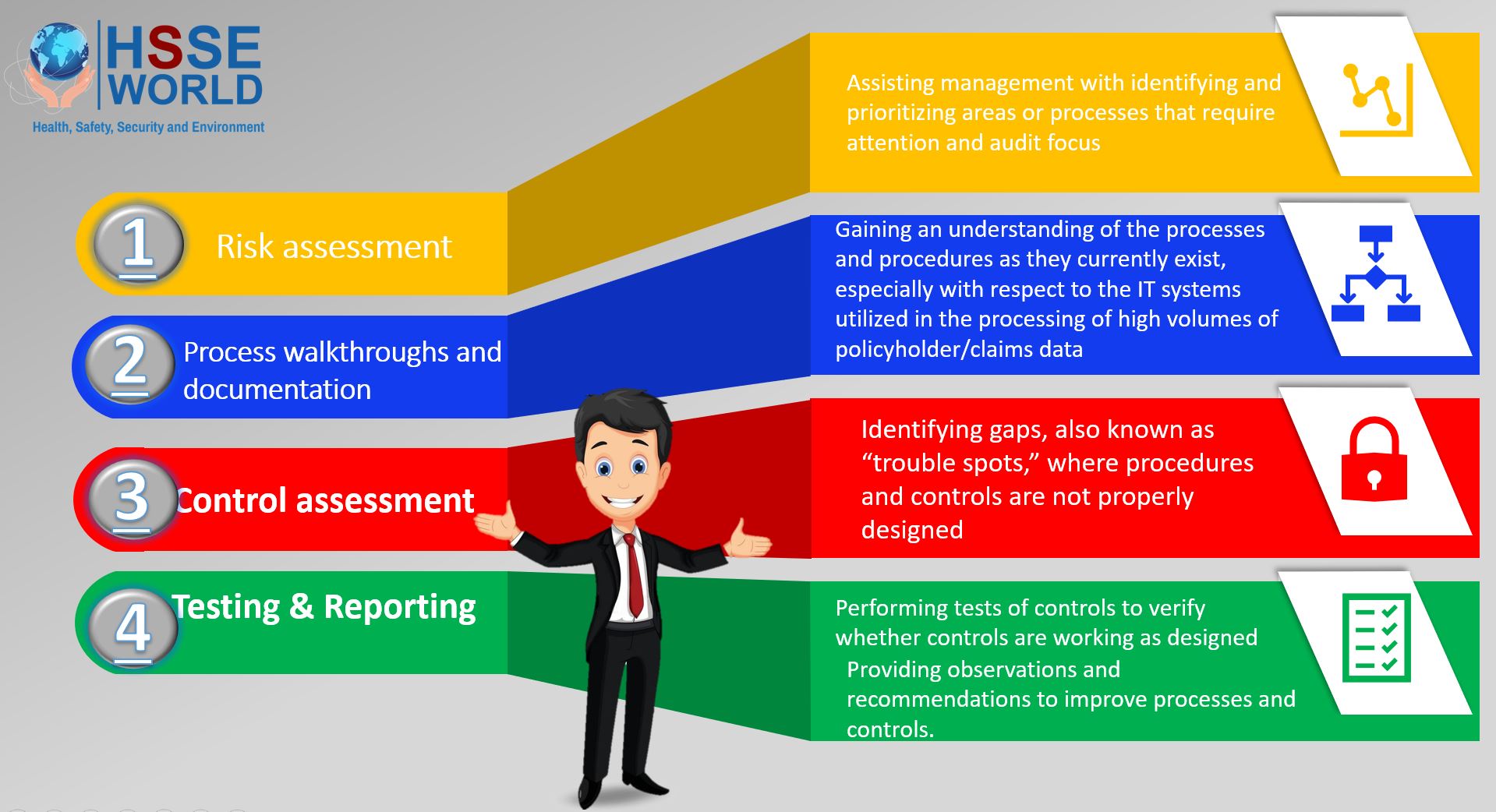What is Internal Auditing?
According to the Institute of Internal Auditors, “internal auditing is an independent, objective assurance and consulting activity designed to add value and improve an organization’s operations. It helps an organization accomplish its objectives by bringing a systematic, disciplined approach to evaluate and improve the effectiveness of risk management, control and governance processes.” Simply said, internal audit is responsible for monitoring the effectiveness of the internal control processes that have been established by management.
How does Internal Audit monitor effectiveness of internal controls?
Internal audit serves many purposes, but the principal tasks include:
- Risk assessment – Assisting management with identifying and prioritizing areas or processes that require attention and audit focus
- Process walkthroughs and documentation – Gaining an understanding of the processes and procedures as they currently exist, especially with respect to the IT systems utilized in the processing of high volumes of policyholder/claims data
- Control assessment – Identifying gaps, also known as “trouble spots,” where procedures and controls are not properly designed
- Testing – Performing tests of controls to verify whether controls are working as designed
- Reporting – Providing observations and recommendations to improve processes and controls.

Risk Assessment
Risk is defined as the probability that an event or action may adversely affect the organization or activity under audit. Internal Audit should certainly participate in management’s entity-level Enterprise Risk Management assessment; but in addition, the more specific purpose of a risk assessment from an audit perspective is to enable the organization to:
- Prioritize audit projects by level of potential risk
- Determine the nature, timing, and extent of internal audit procedures in direct relation to the level of the risk
- Develop a plan for performing internal audit projects in risk areas to minimize the risk of loss to the Company
- Use everyone’s time in an effective and efficient manner
The risk assessment process includes the review of existing documentation such as Prior Audit Findings, the entity’s Strategic Plan, and its Financial Statements, and interviewing department heads and process owners with a focus on “what can go wrong” scenarios.
In particular, Internal Audit would be alert for organizational changes that could potentially impact the management of risk. These shifts could include organizational ethics, management reorganizations, financial demands, resource constraints, technology/internet/E-business, consolidations/alliances, and legislative/regulatory imperatives to name a few.
Benefits of Internal Audit
Having now articulated management’s responsibility for internal controls and how internal audit might play a role in assisting management to fulfill that responsibility, let’s look at some specific benefits that an Internal Audit function can provide to an organization and its management:
- The scope of the internal audit is defined by management or the Board (not an outside agency or adversarial entity)
- Internal Audit “reports” directly to management or the Board (not an outside agency or adversarial entity)
- Improves the “control environment” of the organization
- Makes the organization process-dependent instead of person-dependent
- Identifies redundancies in operational and control procedures and provides recommendations to improve the efficiency and effectiveness of procedures
- Serves as an Early Warning System, enabling deficiencies to be identified and remediated on a timely basis (i.e. prior to external, regulatory or compliance audits)
- Ultimately increases accountability within the organization.
So with a properly staffed internal audit function, management would have, at its fingertips: an advocate, a risk manager, a controls expert, an efficiency specialist, a problem-solving partner and a safety net.
here below we provide HSE Internal Audit Form to be used at your workplace it’s easy to download and consist of the following Scored Elements :
| DESCRIPTION | ELEMENTS | POSSIBLE POINTS | ACTUAL POINTS | SCORE % |
|---|---|---|---|---|
| I. Statistics | 4 | 95 | ||
| II.Management Commitment | 17 | 151 | ||
| III. Employee Involvement | 9 | 56 | ||
| IV. Hazard Prevention | 11 | 123 | ||
| V. Accident Investigation | 13 | 92 | ||
| VI. Safety and Health Training | 12 | 118 | ||
| VII. Occupational Illness Analysis | 8 | 65 | ||
| VIII. OSHA Standards | 20 | 166 | ||
| IX. Medical Programs | 25 | 167 | ||
| X. Emergency Preparedness | 21 | 191 | ||
| XI. Accident Recording System | 7 | 55 | ||
| XII. Safety Committee | 9 | 92 | ||
| XIII. Safety Communication | 5 | 35 | ||
| XIV. Employee Orientation | 7 | 80 | ||
| XV. Plant Hazard | 9 | 93 | ||
| XVI. Supervisor | 12 | 150 | ||
| XVII. Compliance | 8 | 410 | ||
| TOTALS | 197 | 2139 |
More Forms
- Navigating the Risks: The Ultimate Guide to Safety When Working Near Water
- Downloadable Kitchen Safety Inspection Checklist for Restaurants
- Mastering LOTO: Protecting Workers with Energy Isolation and Isolation Confirmation Certificates
- Flammable and Combustible Storage Checklist Free Download
- Secure Your Lifts:Guidelines for Safe Lifting Operations Free Planning Tool
- Sample of Accident Prevention Program ( APP) Template for General Industry Free Download
- Free ISO 14001:2015 Environmental Management System Audit Checklist Download
- Guides for Walking and Working Surfaces Safety Program
- Workshop Safety Guideline and free Posters
- Free Ergonomics Checklist for General Industry
- Work Area Safety Checklist
- Machine Safety and 43-Equipment Inspection Checklists
- Scaffold Safety self Audit and checklist
- Hot Work Controls and its Permit to work Form
- Safety Observation Report Template
- Forklift Operator’s Daily Checklist and safety Tips
- Inspecting Fall Protection Equipment Forms
- Templates: HSE Incentives and rewards
- 35 Inspection forms for Rig Check
- Chemical Risk Assessment form
- 22-Safety Inspection Checklists
- Safety Task Assessment Form
- Suspended Scaffold Pre-Operation Inspection Checklist
- Photo of the day: New worker Orientation & Safety Orientation checklist
- Grating-Decking-Floor- handrail-Removal Form
- Electrical Inspection Checklists
- E-Books: Fire Safety Logbook templates
- General Safety Guidelines and Employee Acknowledgment form
- Annual Internal Audit Form
- Mobile Scaffold Inspection checklist
- Simultaneous Operation (SIMOPS) checklist
- Temporary Construction Facilities (TCF) Inspection checklist
- HIRA, HSE Hazards & Effects Management Process (HEMP) & Risk Register Template
- Hazard Identification Plan (HIP) Template
- Ladder Inspection Form
- Free Pre-Startup Safety Review Checklist (PSSR)
- Hazard Identification Checklist
- Workplace Housekeeping Checklist
- ISO 45001:2018 READINESS CHECKLIST
- Lifting Plan Audit Checklist
- Job Safety Analysis (JSA) Forms What’s Right and Wrong?
- Electrical Isolation Permit to Work forms and checklist
- Canteen Inspection Checklist
- Work at Height Checklist
- Health Safety at Work Improvement Action Plan
- Fire Pump Daily Inspection Checklist
- Construction Site Traffic Management Plan (CSTMP) Guidance
- Safety Templates: COVID-19 Safety Plan
- Workplace Safety Inspections Forms
- Lock Removal Form
- Templates: Management of Change NEW Modified Equipment Safety Checklist
- Lifeline & Harness Inspection Guide checklist
- Contractor Pre-qualification Questionnaire Checklist
- Fall safety at construction checklist
- Construction safety Inspection checklist
- Equipment Safe Operating Procedures- SOP 61 checklist
- Permit to Work (PTW ) AUDIT CHECKLIST
- Hygiene and Sanitation Inspection Checklist
- Pressure Testing Checklist
- Crane Suspended Personnel Platform (MANBASKET) Permit
- Electric Arc Welding and Cutting Checklist
- Laboratory Inspection Checklist Form
- CRANE INSPECTION REPORT
- Scaffold Register and Inspection Checklist
- Portable Ladder Self Inspection checklist
- Process Safety Management (PSM) Compliance checklist
- OSHA Inspection Checklist 8-Pages
- Job Hazard Analysis form
- Incident Report Form
- Safety Inspection Form
- Contractor Weekly HSE Report Form




